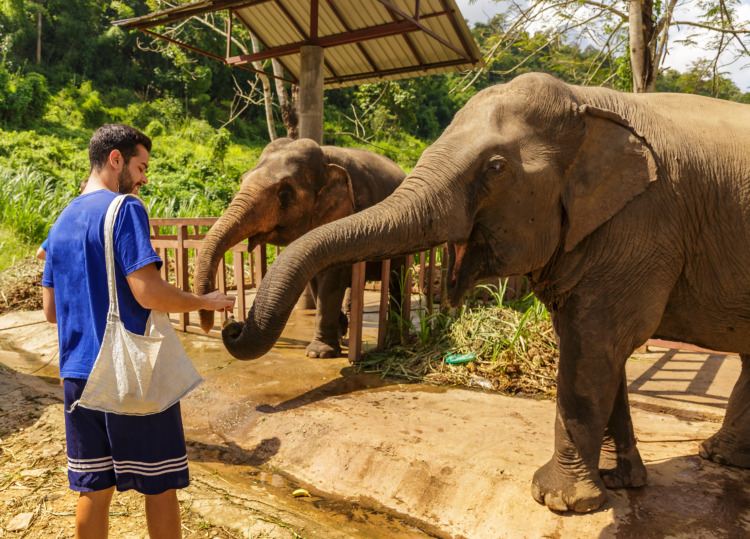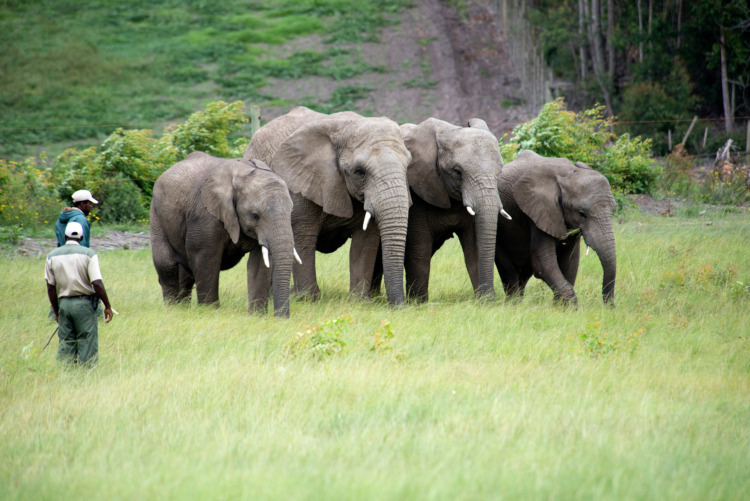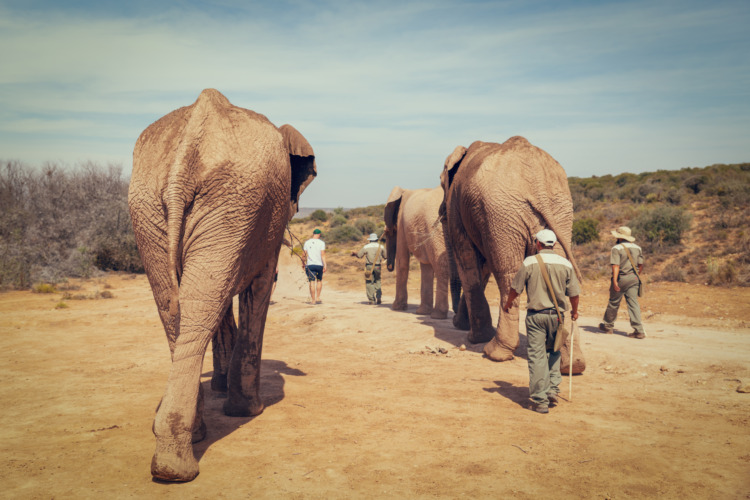Elephants have captured the fascination of people across the globe for centuries, not only because of their grand size but also their intricate social structures and intelligence. Two main species of elephants exist in the world – the African elephant and the Asian elephant. Despite their similarities, several key distinctions between these gentle giants pique the curiosity of animal lovers and conservationists alike.
African elephants can be divided into two distinct subspecies – the African savanna elephant and the African forest elephant. While savanna elephants mainly inhabit sub-Saharan Africa’s wooded savannas and grasslands, the forest elephants reside in the dense rainforests of West and Central Africa.
Meanwhile, Asian elephants are typically found throughout the Indian subcontinent and Southeast Asia, making their home in diverse habitats such as grasslands, swamps, and forests.
The physical differences between African and Asian elephants are easy to observe and offer compelling insights into their respective adaptations for survival.
One such difference is their head shape, with African elephants having a fuller, more rounded, single-dome head, while their Asian counterparts display a twin-domed head with an indent running up the center. These nuances and variations in their habitats, behaviors, and social structures paint a rich tapestry of diversity within the elephant kingdom.
Physical Differences
Ears

African elephants have large, fan-shaped ears, while Asian elephants have smaller, more rounded ears. The size difference is easily noticeable and plays a role in heat regulation for each species, as larger ears help to dissipate excess body heat in the African elephants’ warmer climates.
Tusks

African elephants display tusks in both males and females, used for digging, stripping bark, and as weapons during conflicts. On the other hand, only some male Asian elephants have tusks, and females may possess small, tusk-like protrusions called tushes that are not externally visible.
Trunk

The trunks of both African and Asian elephants serve similar functions, such as smelling, lifting, and communicating. However, the tips of their trunks differ: African elephants have two finger-like projections, while Asian elephants have only one.
Size

African elephants are generally larger than their Asian counterparts. African savanna elephants can weigh up to 12,000 pounds and reach heights of 13 feet at the shoulder, whereas Asian elephants typically weigh around 11,000 pounds and stand up to 11.5 feet tall.
See Related: Difference Between African and Asian Elephants: A Comprehensive Comparison
Head Shape

The head shape of African elephants differs from that of Asian elephants. African elephants have a single-domed head with a rounded appearance, while Asian elephants have a twin-domed head with a divot line running up the middle.
Toenails

The number of toenails per foot varies slightly between the two species. African elephants have four toenails on their front feet and three on their hind feet, while Asian elephants have five on their front feet and four on their hind feet.
Skin Texture

African elephants have more wrinkled skin compared to Asian elephants, the Asian elephant trunk which often appears smoother. Wrinkled skin provides more surface area for heat dissipation and helps to keep African elephants cool in their hot environment.
See Related: Amboseli Trust for Elephants
Geographical Distribution
African Elephants

African elephants are the largest land mammals on Earth and are primarily distributed across the vast landscapes of sub-Saharan Africa. Their range includes a variety of habitats, such as savannas, forests, deserts, and marshes.
They can be further classified into two subspecies: the African forest elephant and the African savanna (or bush) elephant. The African forest elephant inhabits the dense tropical rainforests of Central and West Africa, while the African savanna elephant is more commonly found in the grasslands, savannas, and woodlands of Eastern, Southern, and West Africa.
The geographical distribution of African elephants is not uniform across their range, and their population densities vary according to habitat type, availability of water, and human-related factors such as habitat fragmentation and poaching.
Asian Elephants

Asian elephants, although smaller in size than their African counterparts, are widely distributed across Asia. They are primarily found in 13 countries: India, Sri Lanka, Nepal, Bangladesh, Bhutan, Myanmar, Thailand, Cambodia, Laos, Vietnam, China, Malaysia, and Indonesia.
Unlike African elephants, Asian elephants inhabit a wider array of habitats, ranging from tropical rainforests and swamps to grasslands and temperate forests. However, their populations tend to be concentrated in areas with year-round availability of water and abundant food sources. In recent times, the geographical distribution of Asian elephants has been significantly reduced due to human-induced factors such as habitat loss, agricultural expansion, and urbanization.
An important point to note is that the Asian elephant is further classified into four genetically distinct subspecies: the Indian elephant, the Sri Lankan elephant, the Sumatran elephant, and the Borneo elephant. These subspecies are primarily distinguished by their distribution, morphology, and genetic variations.
Species and Subspecies
African Elephants

African elephants are divided into two subspecies: the African savanna elephant (Loxodonta africana) and the African forest elephant (Loxodonta cyclotis). The African savanna elephant, the African bush elephant, is the largest of the three elephant species. They are found in the grassland savannas and the semi-arid regions of Africa. In contrast to female Asian elephants, African forest elephants are slightly smaller and are found in the dense rainforests of West and Central Africa.
Some key differences between African savanna and African forest elephants include:
- Size: Savanna elephants are larger, weighing 12,000 kg (about 13 tons) and standing 3.96 meters (13 feet) at the shoulder. Forest elephants weigh up to 6,000 kg (about 6.6 tons) and are 2.7 meters (about 9 feet) tall.
- Ears: Savanna elephants have more oversized fan-shaped ears, while forest elephants have smaller, more rounded ears.
- Tusks: Forest elephants have a straighter, downward-pointing tusks, whereas savanna elephants have larger, curved tusks.
- Head: Forest elephants have a single dome-shaped head, while savanna elephants have a more prominent forehead and a slightly concave back.
See Related: What is a Critical Habitat? Everything You Need to Know
Asian Elephants

Asian elephants (Elephas maximus) are another elephant species that mainly inhabit Southeast Asia and the Indian subcontinent. They are smaller than African elephants, weighing up to 5,500 kg (about 6 tons) and standing at most 3.5 meters (11.5 feet) at the shoulder. Based on their geographic distribution and morphological and behavioral traits, Asian elephants are divided into three subspecies:
- Indian elephants (Elephas maximus indicus): Found in mainland Asia, including India, Bangladesh, Bhutan, Myanmar, and Nepal.
- Sumatran elephants (Elephas maximus sumatranus): Found on the island of Sumatra, Indonesia.
- Sri Lankan elephants (Elephas maximus maximus): Found in Sri Lanka.
Differences between Asian and African elephants include:
- Ears: Asian elephants have smaller ears than African elephants’ large fan-shaped ears.
- Head: Asian elephants have a twin-domed head with a divot line running up the middle. African elephants, both savanna and forest, have a single dome-shaped head.
- Trunk: Asian elephants have one finger-like projection at the tip of their trunk, while African elephants have two.
- Skin: Asian elephants have smoother skin with fewer wrinkles than African elephants.
All three species of elephants share similar social structures, with their herds predominantly being matriarchal and led by the oldest female.
Habitats and Diets
African Elephants

African elephants are divided into two subspecies: African forest elephants and African savanna elephants. African forest elephants inhabit the dense rainforests of West and Central Africa, while African savanna elephants mostly inhabit the wooded savannas and grasslands of sub-Saharan Africa. The two different habitats result in some physical differences asian species, such as savanna elephants being larger and having outward-curving tusks.
The diet of African elephants consists mainly of plants, including leaves, bark, fruit, and grasses. They are known to consume up to 300 kilograms (660 pounds) of vegetation daily, and their large size allows them to reach high branches for food. The availability and type of plants in their habitats greatly influence their diets.
Asian Elephants

Asian elephants are found across various countries, such as India, Sri Lanka, and Southeast Asia. Unlike their African counterparts, they generally inhabit moist rainforests, grasslands, and swamps, which predominantly favor savannas and grasslands.
The diet of Asian elephants is also plant-based, consisting of leaves, stems, fruits, and roots. However, their smaller stature limits their reach for high branches, so they tend to forage closer to the ground.
Asian elephants consume an estimated 150 to 200 kilograms (330 to 440 pounds) of plant material daily, slightly less than African elephants. This difference in diet mirrors their differences in habitat, as Asian elephants live in areas with more moisture and denser vegetation.
See Related: International Elephant Foundation
Social Structure and Behavior
African Elephants

African elephants exhibit a complex social structure characterized by matriarchies. These social units are typically led by the oldest female, who has extensive knowledge of environmental resources and threats.
Males disperse from the natal group as they reach adolescence, often forming bachelor groups or living solitary lives. Male African elephants associate with other mature males, forming alliances to support each other in their pursuits.
On the other hand, female African elephants and their offspring stay closely bonded in family groups that often comprise several related females and their young. These family units may join together in larger aggregations, especially during periods of resource abundance or for protection against predators. The matriarch plays a crucial role in directing the movements and activities of the group, with younger individuals relying on her knowledge and experience.
Asian Elephants

The social structure of Asian elephants, while similar in some aspects, exhibits distinct differences from that of African elephants. Like their African counterparts, Asian elephant societies are matriarchal, with the oldest female leading the group. The family units tend to be smaller, often comprising only a few related females and their offspring.
Male Asian elephants, similar to male African elephants, disperse from their natal family groups upon reaching adolescence. However, bachelor male herds are less common in Asian elephants, who are more likely to live solitarily. This difference in social behavior may be attributed to the varied ecological niches that Asian and African elephants inhabit.
To summarize, both African and Asian elephants exhibit matriarchal societies led by the oldest of female elephants, but they differ in the behavior and social patterns of male individuals, as well as the size and composition of family units. These variations could be a reflection of the distinct environments and ecological challenges faced by each species.
Conservation and Threats
African Elephants

The International Union for the Conservation of Nature (IUCN) currently categorizes African elephants as vulnerable. They are threatened primarily by poaching for the illegal ivory trade. Additionally, habitat loss and fragmentation have contributed to their declining numbers.
African elephants are divided into two species: the African forest elephant and the African savanna elephant. These large mammals have distinct social structures, which involve familial bonds and herd interactions, making the effects of poaching even more detrimental.
Some conservation efforts include organizations like the World Wildlife Fund (WWF), which work towards protecting both the elephants themselves and their habitats. Furthermore, education and awareness campaigns, as well as anti-poaching initiatives, are necessary to combat the threats these animals face.
Asian Elephants

Asian elephants are classified as critically endangered, by the IUCN, with habitat loss posing the most significant threat to their survival. Due to deforestation and human encroachment, Asian elephants have experienced a decrease in living space. This has led to human-elephant conflict as the elephants venture into agricultural areas, often resulting in retaliation from local communities.
Conservation actions for Asian elephants also involve organizations such as the WWF, focusing on habitat protection and restoration. In addition, efforts to reduce human-elephant conflict through education and innovative solutions, like early warning systems or fencing, are crucial for the long-term coexistence of these elephants and their human neighbors.
Efforts to protect both African and Asian elephants involve the collaboration of governments, conservation organizations, and local communities. By working together to address the threats of poaching, habitat loss, and human-elephant conflict, it is possible to ensure a brighter future for these magnificent creatures.
See Related: Elephant Action League
Distinctive Features Summary
African and Asian elephants exhibit several physical differences, making distinguishing between the two species easy. One of the most prominent differences lies in the size and shape of their ears. African elephants have large, fan-shaped ears resembling the African continent, while Asian elephants possess smaller, rounded ears. The larger ears of African elephants aid in dissipating more heat, a feature crucial for surviving in the hotter African climate.
The head shape further separates the two elephant species. African elephants have fuller, rounded heads with a single dome shape. In contrast, Asian elephants display a twin-domed head with an indent running up the center.
It is essential to note the difference in their lower lips as well. African elephants have long and tapered lower lips, while Asian elephants showcase shorter, rounder lower lips. This distinction is critical when examining their feeding habits and the types of vegetation they consume.
In summary, the primary features that set African and Asian elephants apart include their ear size and shape, head structure, and lower lip appearance. These physical differences add to their unique appearances and significantly influence their adaptability and survival in their respective habitats.
Frequently Asked Questions
What are the main physical differences between African and Asian elephants?
African elephants are generally larger, with bulls reaching heights up to 4 meters. The world’s largest land mammal, Asian males usually don’t grow taller than 3.5 meters. African elephants have larger, fan-shaped ears compared to the smaller ears of Asian elephants.
Moreover, African elephants have two finger-like projections on their trunk tips, while Asian elephants have only one. Lastly, nail differences also distinguish them; African savanna elephants have four nails on their front feet and three on their back feet, while Asian elephants have five nails on the front and four on the back feet.
Can African and Asian elephants interbreed?
No, African and Asian elephants cannot interbreed due to their genetic differences. As separate species, they have evolved independently and developed distinct characteristics.
Do both Asian and African elephants have tusks?
Not all elephants have tusks. While male and female African elephants generally grow tusks, in Asian elephants, only males grow them. However, not all males will develop tusks.
How does the behavior of African elephants contrast with that of Asian elephants?
African and Asian elephants have similar sociality, with defined social structures where herds are matriarchies led by the oldest female. However, Asian elephants tend to be less aggressive and more docile than their African counterparts. This difference in temperament may be partly due to habitat variation and human interaction.
Are there differences in habitat between African and Asian elephants?
Yes, there are differences in habitat. African elephants are primarily found in various African environments, including savannas, forests, and deserts.
Asian elephants inhabit Southeast Asia’s grasslands, forests, swamps, and the Indian subcontinent. The variation in habitat plays a significant role in shaping their behavior, diet, and social structure.
How do the social structures of African and Asian elephants vary?
The social structures of both African and Asian elephants are predominantly matriarchal, with herds led by the oldest female. However, African elephant herds tend to be larger, often consisting of many related females and their offspring.
In contrast, Asian elephant herds are typically smaller, with fewer direct family members. Male elephants of both species usually leave the herd when they reach adolescence to form temporary bachelor groups or live solitarily.
Related Resources
- Ways Climate Change is Affecting Animals
- Different Animals That Can’t Jump
- Animals That Have Gone Extinct Due to Deforestation


